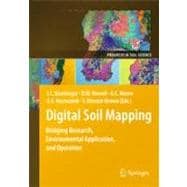
| Introduction | |
| Current State of Digital Soil Mapping and What Is Next | p. 3 |
| Research | |
| Environmental Covariates and Soil Sampling | |
| Environmental Covariates for Digital Soil Mapping in the Western USA | p. 17 |
| A Generalized Additive Soil Depth Model for a Mountainous Semi-Arid Watershed Based Upon Topographic and Land Cover Attributes | p. 29 |
| Applying Geochronology in Predictive Digital Mapping of Soils | p. 43 |
| Scale Effects on Terrain Attribute Calculation and Their Use as Environmental Covariates for Digital Soil Mapping | p. 55 |
| Conditioned Latin Hypercube Sampling: Optimal Sample Size for Digital Soil Mapping of Arid Rangelands in Utah, USA | p. 67 |
| Soil Sensors and Remote Sensing | |
| Using Proximal Soil Sensors for Digital Soil Mapping | p. 79 |
| The Use of Hyperspectral Imagery for Digital Soil Mapping in Mediterranean Areas | p. 93 |
| Automatic Interpretation of Quickbird Imagery for Digital Soil Mapping, North Caspian Region, Russia | p. 103 |
| ASTER-Based Vegetation Map to Improve Soil Modeling in Remote Areas | p. 113 |
| Digital Soil Boundary Detection Using Quantitative Hydrologic Remote Sensing | p. 123 |
| Soil Inference Systems | |
| Homosoil, a Methodology for Quantitative Extrapolation of Soil Information Across the Globe | p. 137 |
| Artificial Neural Network and Decision Tree in Predictive Soil Mapping of Hoi Num Rin Sub-Watershed, Thailand | p. 151 |
| Evaluation of the Transferability of a Knowledge-Based Soil-Landscape Model | p. 165 |
| Random Forests Applied as a Soil Spatial Predictive Model in Arid Utah | p. 179 |
| Two Methods for Using Legacy Data in Digital Soil Mapping | p. 191 |
| Environmental Application and Assessment | |
| Mapping Heavy Metal Content in Soils with Multi-Kernel SVR and LiDAR Derived Data | p. 205 |
| Mapping the CN Ratio of the Forest Litters in Europe-Lessons for Global Digital Soil Mapping | p. 217 |
| Spatial Prediction and Uncertainty Assessment of Soil Organic Carbon in Hebei Province, China | p. 227 |
| Estimating Soil Organic Matter Content by Regression Kriging | p. 241 |
| Digital Soil Mapping of Topsoil Organic Carbon Content of Rio de Janeiro State, Brazil | p. 255 |
| Comparing Decision Tree Modeling and Indicator Kriging for Mapping the Extent of Organic Soils in Denmark | p. 267 |
| Modeling Wind Erosion Events - Bridging the Gap Between Digital Soil Mapping and Digital Soil Risk Assessment | p. 281 |
| Making Digital Soil Mapping Operational | |
| Soilscapes Basis for Digital Soil Mapping in New Zealand | p. 297 |
| Legacy Soil Data Harmonization and Database Development | p. 309 |
| Toward Digital Soil Mapping in Canada: Existing Soil Survey Data and Related Expert Knowledge | p. 325 |
| Predictive Ecosystem Mapping (PEM) for 8.2 Million ha of Forestland, British Columbia, Canada | p. 337 |
| Building Digital Soil Mapping Capacity in the Natural Resources Conservation Service: Mojave Desert Operational Initiative | p. 357 |
| A Qualitative Comparison of Conventional Soil Survey and Digital Soil Mapping Approaches | p. 369 |
| Applying the Optimum Index Factor to Multiple Data Types in Soil Survey | p. 385 |
| US. Department of Agriculture (USDA) TEUI Geospatial Toolkit: An Operational Ecosystem Inventory Application | p. 399 |
| Predictive Soil Maps Based on Geomorphic Mapping, Remote Sensing, and Soil Databases in the Desert Southwest | p. 411 |
| GlobalSoilMap.net - A New Digital Soil Map of the World | p. 423 |
| Methodologies for Global Soil Mapping | p. 429 |
| Index | p. 437 |
| Table of Contents provided by Ingram. All Rights Reserved. |
The New copy of this book will include any supplemental materials advertised. Please check the title of the book to determine if it should include any access cards, study guides, lab manuals, CDs, etc.
The Used, Rental and eBook copies of this book are not guaranteed to include any supplemental materials. Typically, only the book itself is included. This is true even if the title states it includes any access cards, study guides, lab manuals, CDs, etc.